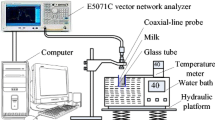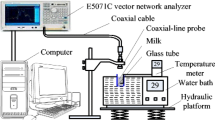Abstract
For microwave heating pasteurization processes, knowledge of the dielectric characteristics of foods are very important. In this paper, we present the dielectric properties of raw soy milk and commercial packed soy milk of four different flavors (light, natural, chocolate and pecan) from 500 MHz to 20 GHz, covering most of the assigned frequencies by the Federal Communications Commission for heating purposes. Experiments were performed using an open-ended-coaxial probe and a vector network analyzer. This characterization was carried out for temperatures ranging from 20 to 70 °C in steps of 10 °C. The dielectric constant of soy milks decreased with increasing frequency, while increasing temperature resulted in decreasing of the values. The dielectric loss factor presents a U shape behavior, where the loss started decreasing from 500 MHz to about 3 GHz and then, it increased again up to 20 GHz. In addition, higher temperatures decreased the dielectric loss. Applying the higher order Debye´s equation, two relaxation times were calculated for the soymilks, with good agreement with the measured properties. Deeper penetration of microwaves were obtained for raw soy milk at 915 MHz, making it suitable for microwave pasteurization.



Similar content being viewed by others
References
Ahmed J, Ramaswamy HS, Raghavan GSV (2008) Dielectric properties of soybean protein isolate dispersions as a function of concentration, temperature and pH. LWT—Food Sci Technol 41(1):71–81
Alifakı YÖ, Şakıyan Ö (2017) Dielectric properties, optimum formulation and microwave baking conditions of chickpea cakes. J Food Sci Technol 54(4):944–953
Clare DA, Bang WS, Cartwright G, Drake MA, Coronel P, Simunovic J (2005) Comparison of sensory, microbiological, and biochemical parameters of microwave versus indirect UHT fluid skim milk during storage. J Dairy Sci 88(12):4172–4182
Coronel P, Simunovic J, Sandeep KP, Kumar P (2008) Dielectric properties of pumpable food at 915 MHz. Int J Food Prop 11(3):508–518
Duhamel F, Huynen I, Vander Vorst A (1997) Measurements of complex permittivity of biological and organic liquids up to 110 GHz. In: IEEE MTT-S International Microwave Symposium Digest 1997, vol 1, pp 107–110
Franco AP, Yamamoto LY, Tadini CC, Gut JAW (2015) Dielectric properties of green coconut water relevant to microwave processing: effect of temperature and field frequency. J Food Eng 155:69–78
Guo W, Zhu X, Liu H, Yue R, Wang S (2010) Effects of milk concentration and freshness on microwave dielectric properties. J Food Eng 99(3):344–350
Jaynes HO (1975) Microwave pasteurization of milk. J Milk Food Technol 38(7):386–387
Komarov V, Wang S, Tang J (2005) Permittivity and measurements. In: Chang K (ed) Encyclopedia of RF and microwave engineering. Wiley, New York, pp 3693–3711
Kudra T, Raghavan V, Akyel C, Bosisio R, Van de Voort F (1992) Electromagnetic properties of milk and its constituents at 2.45 GHz. J Microw Power Electromagn Energy 27(4):199–204
Metaxas AC, Meredith RJ (1993) Industrial microwave heating. Peter Peregrinus Ltd, London
Muraro MA, Giampietro PG, Galli E (2002) Soy formulas and nonbovine milk. Annals Allergy, Asthma Inmunol 89(6):97–101
Murugkar DA (2014) Effect of sprouting of soybean on the chemical composition and quality of soymilk and tofu. J Food Sci Technol 51(5):915–921
Nelson SO, Trabelsi S (2012) Factors influencing the dielectric properties of agricultural and food products. J Microw Power Electromagn Energy 46(2):93–107
Nunes AC, Bohigas X, Tejada J (2006) Dielectric study of milk for frequencies between 1 and 20 GHz. J Food Eng 76:250–255
Oupadissakoon G, Chambers DH, Chambers E IV (2009) Comparison of the sensory properties of ultra-high-temperature (UHT) milk from different countries. J Sensory Stud 24(3):427–440
Ryynänen S (1995) The electromagnetic properties of food materials: a raw of basic principles. J Food Eng 26:409–429
Salazar-González C, San Martín-González MF, López-Malo A, Sosa-Morales ME (2012) Recent studies related to microwave processing of fluid foods. Food Bioproc Technol 5(1):31–46
Schiffmann RF (1995) Microwave and dielectric drying. In: Majumdar AS (ed) Handbook of industrial drying, 2nd edn. Marcel Dekker, New York, pp 345–372
Sosa-Morales ME, Valerio-Junco L, García HS, López-Malo A (2010) Dielectric properties of foods: reported data in the 21st century and their potential applications. LWT- Food Sci Technol 43:1169–1179
Torrealba-Meléndez R, Sosa-Morales ME, Olvera-Cervantes JL, Corona-Chávez A (2015) Dielectric properties of cereals at frequencies useful for processes with microwave heating. J Food Sci Technol 52(12):8403–8409
USDA United States Department of Agriculture (2000) Kinetics of microbial inactivation for alternative food processing technologies. Microwave and radio frequency processing. http://www.fda.gov/Food/FoodScienceResearch/SafePracticesforFoodProcesses/ucm100250.htm
Zhu X, Guo W, Jia Y (2014) Temperature-dependent dielectric properties or raw cow´s and goat´s milk from 10 to 4,500 MHz relevant to Radio-frequency and Microwave Pasteurization. Food Bioproc Technol 7(6):1830–1839
Acknowledgements
Authors would like to thank CONACYT (Consejo Nacional de Ciencia y Tecnología, México) for financial support through the Project 180061, and PRODEP-NPTC UGTO 543/2016.
Author information
Authors and Affiliations
Corresponding author
Rights and permissions
About this article
Cite this article
Kataria, T.K., Corona-Chávez, A., Olvera-Cervantes, J.L. et al. Dielectric characterization of raw and packed soy milks from 0.5 to 20 GHz at temperatures from 20 to 70 ºC. J Food Sci Technol 55, 3119–3126 (2018). https://doi.org/10.1007/s13197-018-3238-3
Revised:
Accepted:
Published:
Issue Date:
DOI: https://doi.org/10.1007/s13197-018-3238-3




